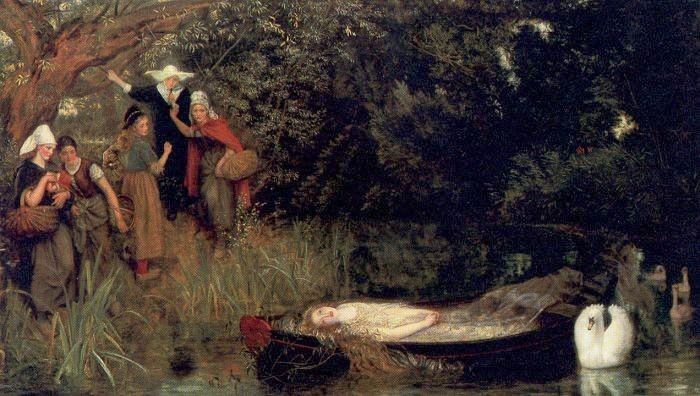Elaine's story, as told in medieval literature and as retold by Tennyson, is about a girl that falls in love with Sir Lancelot before he fights in a tournament. Elaine asks him to wear a token of hers at the tournament, and he accepts. He is wounded, and brought to Elaine’s chambers. After he heals, he rejects her affections, and Elaine dies of heartbreak. Her body is placed on a boat, and she floats down to Camelot. She had written a letter to Lancelot, which is read aloud in front of the court. Lancelot explains how he accidentally broke Elaine's heart, and then pays for a rich funeral.
Alfred, Lord Tennyson’s Idylls of the King, a cycle of twelve narrative poems that retell Arthurian tales, was published between 1859 and 1885. The Idylls is a work of Victorian poetry, but incorporates Gothic interiors and Romantic descriptions of nature. This call to the past—to the medieval past and to the Gothic and Romantic pasts—combines several different moments in time and stylistic periods into one body of literature. Similarly, illustrations paired with Tennyson’s work are combinations of art movements combined into one grand aesthetic. While the Idylls were being published, the Arthurian illustrators painted in botanical landscapes, references to Gothic styles, and bright colors. The beautiful women of Arthurian legend—Guinevere, the Lady of the Lake, and of course, the Lady of Shalott were popular subjects of Arthurian illustrators in the 19th century (and into the 20th). Elaine floating down the river was among the most common subjects. Many of the artists that painted and illustrated Elaine’s story were part of a group known as the pre-Raphaelites. Inspired by Elaine’s youth, unrequited love, and death, the group popularized her for a Victorian audience to the point where her story became even more well-known than it was in the medieval period.
Tennyson took inspiration from the Italian “La Damigella di Scalot”’ of Il Novellino as well as the French Mort Artu when drafting the 19th-century "Lady of Shalott" and "Lancelot and Elaine."

The Lady of Shalott painted by Arthur Hughes
In La Mort Artu, the descriptions of Elaine’s barge are very visual in that Arthur and Gauvain both see the boat and Elaine's body within it. Perhaps it is because of this inherently visual description that the passage describing Elaine drifting towards Camelot in her barge is so often illustrated. While different illuminators and illustrators had unique styles, their illustrations would appear at the similar points in the text and depict similar scenes.